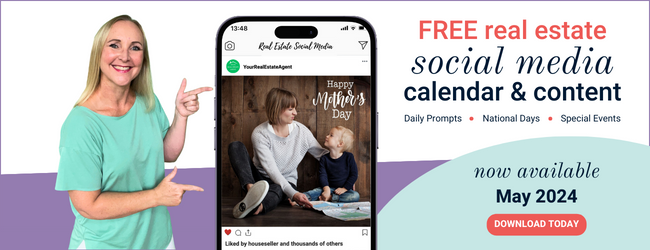To get the most out of your real estate marketing; monitor key statistics and interpret the results. Once you know which activities bring you the best bang for your buck, it becomes easier to calculate a marketing budget to achieve your desired income.
Many real estate agents are now using digital tools in order to promote their services and their personal brands – and this is great, as it shows agents are taking their marketing more seriously. But the thing that strikes me regularly about real estate marketing is just how many misconceptions and missed opportunities there seem to be when it comes to the digital world.
Know the difference between sales and marketing
Contrary to what some people think, sales and marketing aren’t the same. Sales is about converting leads into clients. The results tend to be fast, and often agents who have previously concentrated heavily on sales expect the same from their marketing. When their marketing efforts don’t yield an influx of immediate sales, they come to the misinformed conclusion that their marketing hasn’t been effective.
However, marketing is different. Its function is to aid sales by making your target audience aware of your real estate agency in order to generate more leads. It takes time, commitment and persistence – remember, the aim is to make people aware of you, so they can become interested enough in what you offer that they’ll be compelled to get in touch.
It’s worth remembering that it can take several weeks or even months, and up to seven points of contact, for sellers to want to take the action of contacting a particular real estate agent once they’re ready to sell their property. This is why it’s vital to persevere with your digital marketing activities – obviously you’d like to see some quick results, but over time you’ll see a drastic increase in the number of leads your marketing is bringing in.

Understand how to measure your ‘real estate marketing’ success
It’s one thing to know you need to start promoting your brand in the digital world, simply because you see everyone on their smart devices every day – it’s easy to recognise the fact that there’s a huge market there to be tapped. But without knowing how to measure the performance of your marketing activity, how can you judge its success? If you want to get your marketing right, you’ll have to learn how to interpret the numbers so you can identify the gems that can be mined further in order to generate more leads for your real estate agency.
This can be particularly tricky when it comes to real estate marketing, in comparison to any other industry. You’re an individual sales agent – but you’re also a representative of a brand. Therefore your marketing is likely to be spread out over a variety of different digital locations online, making it difficult to determine which specific marketing activity resulted in each phone call or email.
Make sure all contact methods lead to the same end point
What does this mean? Think about how things are done in most other industries. Companies don’t tend to publish their entire staff directories on the web, so it’s easier for them to monitor the exact sources of their inbound enquiries. This model has now been adopted for real estate marketing by portals such as Realestate.com.au and Domain.com.au – they never reveal individual agents’ phone numbers or email addresses unless visitors click through. All enquiries are filtered through their form and procedures, allowing them to produce detailed reports of the numbers of views, clicks and enquiries each agent has received.

Many of the franchise brands are now also starting to use this system. Independent brands and individual agents who are still publishing all their information online without any form of tracking mechanism are now at a disadvantage, as they’re virtually unable to monitor which of their digital marketing efforts are yielding the best results in terms of lead generation.
So what’s the answer? You need to start monitoring your statistics, and there are three main areas that count the most.
1. Website traffic
This is not just the number of visits your website is receiving. For that number to mean anything useful, you need to know how your visitors got there – which of your online ads did they click on in order to arrive at your site? For example, was it a paid search ad or one of your social media marketing campaigns?
It also helps to know more details about their visit to your site itself, such as how long they spent on the site, how many pages they visited and which page they converted on. A tool such as Google Analytics, Hotjar or Crazy Egg can show you these details.
It may not be immediately obvious how this information can help, but it gives you vital details about the audience you’re reaching. It can show you in detail how your brand awareness is growing, and which target group it is growing amongst the quickest. Are you reaching people who are actually likely to become customers? If not, you can adjust your marketing efforts accordingly.
It can also show you which of your campaigns is driving the most clicks – it’s great to have plenty of social media followers, but your marketing needs to incentivise them to visit your website, where you can really start engaging with them. Your blog is another area to monitor, as it shows you whether or not your content is engaging with the right people.
Even if a visitor to your website didn’t convert, all is not lost – you can easily leave a cookie, on their computer or mobile device, to enable you to retarget them, keeping your brand uppermost in their mind.
2. Email subscribers
Even in this age of social media, you really need to make sure your marketing is still encouraging people to sign up to your email list. Email has several advantages over other forms of digital communication, but the biggest advantage is that you’ve captured your leads and can reach out to them on a one to one basis.

Firstly, social media can be unreliable in terms of the audience it allows us to reach. We are at the mercy of algorithms and competing advertisers – on average, a social media post will only reach three or four percent of your followers. Email, however, targets the individual recipient. Most people still check their emails religiously, so you know your message is reaching them.
Email is also easy to personalise, by including the recipient’s name, and slipping in information about things they have previously shown an interest in. This allows you to “drip feed” information about the services you provide, building up a picture, piece by piece, at timely intervals.
If you’re really tech savvy, you can even automate this process, and the best part is your emails can still appear as personalised so the recipient will believe they’ve been written individually for them! This will help to reduce your marketing workload.
3. Enquiries or leads
Of course, what you ultimately need to know is how many leads your marketing efforts are generating. These are people who have a need for your service and are interested enough to become customers – those who have actually gone as far as making a phone call to you or filling in your online contact form.
This is where you have an opportunity to turn your marketing efforts into sales. As soon as the opportunity presents itself, you need to be quick – a communication should be the trigger for you to convert a lead into a client, and ultimately, a sale. This process will be much easier if you ensure you have automated procedures in place to keep leads warm until you’re in a position to move in and clinch the deal.

Other real estate marketing statistics worth monitoring
If your marketing is not significantly improving the main three areas, then you should think about revisiting and adjusting your tactics. However, if it is beginning to work for you and you simply feel it needs fine-tuning, then it can be worth delving a little deeper. For example, which of your social media posts are driving the most engagement – are they organic posts or paid advertising? What do your levels of social engagement look like – how many times was your post liked and shared, and how many comments did it receive? This will illustrate whether your social media marketing is on the right track.
The same goes for the traffic that has come to you via search engines – was it a paid search or organic? Did they find you via another type of marketing such as print media or an event? In addition, you can improve your search engine rankings by contributing articles to other people’s websites, and including reciprocal links in your content – it’s important to monitor this activity too.
How and when to monitor your stats
Looking at this information every month can give you an idea of how your traffic and enquiries are growing over time – ideally you should be seeing a gradual increase. Don’t forget, some times of year will be busier than others; you’ll probably see a peak in the main selling season between September and December, and a small rise around the Easter period. In Australia, few sales are made over Christmas and New Year, but this isn’t the case in New Zealand, so it’s important to be aware of your local climate.
Reverse engineer the numbers
Once you have all the vital information you need, you can then see which of your marketing areas are performing the best. This will inform you of where the majority of your marketing budget should be going in the future, as well as which areas you need to improve. It’s important to keep a presence in all seven contact areas, but it’s well worth investing more in the areas that are creating the most leads.

Another way to use the numbers is to work out how many leads you need to generate, on average, each year in order to attain the level of sales you need to give you the annual income you want. You can then work backwards to determine how much you need to be investing in your marketing efforts.
So, by closing the information loop, and arming yourself with all the necessary statistics, you’ll soon find that digital marketing isn’t just about having an online presence – it’s a highly effective way of growing your real estate business revenues. Stick with it, and monitor the numbers, because given time you too can learn how to make it work for you!


Join the Conversation - add your thoughts